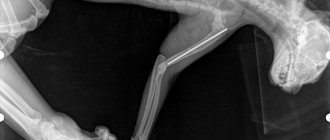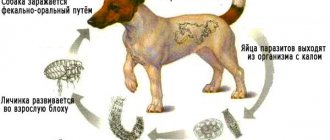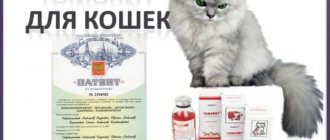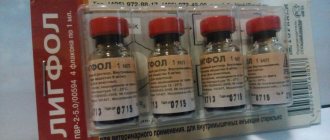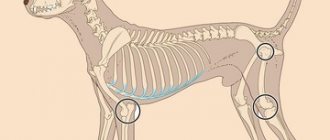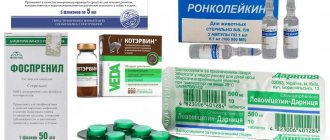Release forms, composition
For ease of use, the medicine is available in two forms: tablets and injections.
Liquid form
The bottle is filled with a light yellow liquid. Each 20 ml ampoule contains 20 mg of maropitant citrate. The bottles are sealed with stoppers. The medication is packaged in separate paper boxes, each of which is accompanied by detailed instructions.
Pills
Oblong yellow tablets are packaged in aluminum blisters of 4 pieces. The drug is presented in four dosages. Depending on the volume of the tablet, the amount of the active substance, maropitant citrate, varies: 100 mg (16 mg maropitant), 150 mg (24 mg), 375 mg (60 mg) and 1000 mg (160 mg). The composition also includes additional components: stearate, lactose, cellulose, croscarmellose sodium and dye.
Dosage form
Sereniya is available in two versions - solution for injections and tablets. Each form has its own characteristics. The instructions for use indicate that Sereniya tablets are designed for dogs, although in practice it can also be used for cats. This indication is only available due to the lack of the necessary patent.
Injection solution
Externally, it is a transparent liquid, which is characterized by a yellowish color. Glass bottles are used for packaging medicinal liquid. To maintain tightness, they are sealed with rubber stoppers, which are rolled up with aluminum lids. The injection solution is packaged in 20 ml. The manufacturer does not provide packaging of other sizes.
The active substance that provides the antiemetic effect of the drug is maropitant citrate. The drug also contains thoroughly purified water, sulfobutyl ether, metacresol and sodium beta-cyclodexitrin.
Important! A hermetically sealed drug can be stored for 3 years from the date of manufacture, but after opening the bottle, the medicine is suitable for use only for 90 days.
Compound
Active ingredients: maropitant citrate – 10 mg;
Excipients: metacresol - 3.3 mg, sodium β-cyclodextrin sulfobutyl ether - 63 mg, water for injection - up to 1 ml.
Storage conditions
If stored correctly, the drug can be used for three years from the date of manufacture. But if you open the bottle, then its contents will have to be used promptly - within four weeks. After this period, the remaining solution will need to be poured out, and the empty bottle will need to be thrown away; it cannot be used for any household purposes.
Sereniya, like most pharmaceutical drugs, should be stored in a dry place, separate from food and feed products at a temperature not exceeding 30 degrees. You can’t freeze Serenia, otherwise it will lose its medicinal properties.
Serenia solution must remain transparent and homogeneous
A solution that for any reason has lost transparency, is cloudy, has sediment or any foreign inclusions, should not be used and must be disposed of.
Pills
The tablet form of Serenia is marketed as an antiemetic for dogs, but veterinarians often prescribe this type of drug for cats . It should be noted that of the four types of tablets offered by the manufacturer, differing in the concentration of maropitant, only two are suitable for cats, with the lowest content of the active ingredient: 16 or 24 milligrams.
Serenia for dogs is available in four tablet versions
These pills weigh 100 and 150 milligrams, respectively, and are packaged in cardboard boxes with a green or lilac background. Each package contains a blister with four yellowish tablets, appropriately marked, as well as detailed instructions. The tablets are oval in shape and divided in half by a transverse line, which helps to accurately adhere to the dosage of the drug when used. In addition, on one side of each tablet there is an inscription indicating the concentration of the active substance.
Serenia's yellowish tablets are oval in shape.
Serenia in tablets can be used for cats only in cases where the doctor considers it acceptable; He will also prescribe the optimal dosage according to the weight of the animal. Do not use the drug at your own discretion - self-medication will bring nothing but harm to your pet.
Compound
The composition of the tablets, like the injection solution, is based on the active compound - maropitant citrate. Also in the formula of the drug there are excipients characteristic of the tablet form of the drug Sereniya:
- magnesium stearate;
- microcrystalline cellulose;
- lactose monohydrate;
- croscarmellose sodium;
- dye E110.
Storage conditions
The tablet form of Serenia should be stored under the same conditions as the solution for injections. When purchasing tablets, especially individually, make sure that the seal of the aluminum blister is not broken. Opening the package radically shortens the shelf life of the drug: Serenia tablets in a blister can be stored for up to three years, and after opening - no more than two days.
Open the blister immediately before using the tablets
It is important to take precautions when working with Sereniya:
- remove the drug from direct access to animals and small children;
- avoid contact of the product with the skin and mucous membranes;
- Before and after using Serenia, wash your hands well with soap.
Wash your hands thoroughly before and after using Serenia
pharmachologic effect
The effectiveness of the drug is based on maropitant citrate. It has an antiemetic effect, relieving the symptoms of vomiting, regardless of the cause of their occurrence. The main component of the medicine copes well with symptoms of both central and peripheral origin (indigestion). By partially blocking the central nervous system, maropitant citrate completely eliminates the gag reflex in the animal.
The medicine quickly penetrates the bloodstream. When administered subcutaneously, the highest concentration is achieved after 45 minutes. Metabolism of the main active substance occurs in the liver. Residues of the medication are excreted in feces and urine. With repeated use, the product gradually accumulates in the dog’s body.
If Sereniya is used in tablet form, the maximum concentration of the drug in the blood depends on the dosage. When using 2 mg of the drug per 1 kg of weight, the peak is recorded after 2 hours. If the dose is 8 mg per kilogram – after one and a half. The drug is partially eliminated within 4 hours.
In veterinary medicine, Serenia is considered a moderately toxic and safe drug. Tablets can be given with food: food intake does not affect absorption.
Dosage and instructions for use
The most used dosage form of Serenia is tablets. They should be given to a cat at the rate of 8 mg of active substance per 1 kg of animal weight. For preventive purposes, the medicine is given once 2 hours before the trip.
To stop vomiting that has already occurred, it is best to use injections. For a cat, the optimal dose of the drug is also calculated based on its weight: 1 ml per 10 kg. Injections should be given once a day for no more than 5 days in a row. Serenia injections are given subcutaneously.
Subcutaneous injections are usually given to a cat at the withers - the fold of skin between the neck and back
For injection, it is best to use an insulin syringe, since it makes it easier to select the right amount of the drug.
Video: how to give a cat a subcutaneous injection
Special instructions and precautions
Injections of this veterinary drug are quite painful, so before the procedure the cat must be secured with a towel or sheet.
Serenia is a drug that is safe for humans, however, when coming into contact with the drug, precautions should be taken, such as using medical gloves and washing hands with soap after procedures.
Indications
The drug Sereniya for the treatment of dogs is prescribed in the following cases:
- with a tendency to motion sickness;
- to relieve the gag reflex after anesthesia;
- for gastrointestinal diseases;
- after severe poisoning;
- during chemotherapy for the treatment of cancer.
And yet, the main use of the drug is related to the relief and prevention of vomiting syndrome in animals during transportation by land, air or sea. We can conclude that the pet is seasick if there is at least one of the following signs:
- increased salivation;
- swallowing saliva, rapid breathing;
- tremor;
- nervous state and anxiety;
- belching;
- vomit.
Some breeds may exhibit only one of the above symptoms, while others may exhibit all of them at once. But if there is at least one sign, most likely your pet is suffering from motion sickness. The disease only gets worse from stress. Many dogs understand that traveling in a car is associated with unpleasant sensations. Some people feel sick just by the sight of a car.
Antiemetics
Vomiting is a common clinical sign in small animal veterinary practice. It requires a rational approach to treatment, based primarily on the suspected or established pathology. A complete and detailed history is necessary to evaluate an animal with vomiting. It is most important to distinguish vomiting from regurgitation, since their etiology, on which specific diagnostic tests depend, is different. Regurgitation is a passive process where undigested food or saliva is expelled spontaneously under the influence of gravity, while vomiting is a reflex accompanied by signs of nausea, increased salivation and contractions of the abdominal muscles.
Maropitant. Trade name Serenia/Cerenia
This drug acts as an antiemetic by blocking the neurokinin-1 (NK1) receptor. Neurokinin-1 is a neurotransmitter that initiates vomiting from the vomiting center. Although NK1 receptors are involved in other physiological and behavioral responses, at doses used to control vomiting, no side effects associated with blockade of other receptors have been reported. Maropitant can inhibit emesis, which is stimulated by both central and peripheral sources mediated by acetylcholine, histamine, dopamine and serotonin. The NK1 receptor is also involved in pain transmission (via substance P). NK1 receptor blockade may have potential as an adjunctive treatment for some types of pain (eg, visceral pain), but there are currently no clinical studies demonstrating an analgesic effect from maropitant. [1], [2], [3], [7]
The drug effectively suppresses vomiting from chemotherapy, gastrointestinal diseases, intoxication, kidney disease, vestibular irritants (sickness). [4]
Adverse reactions: pain during injection. Very high doses in cats may cause hemolysis. Injections should not be mixed with any other product, since there are no studies on compatibility.
Maropitant is available as 16, 24, 60 or 160 mg tablets and 10 mg/mL injection. However, the tablet form is not available in the Russian Federation.
Dosage: dogs, cats: 1 mg/kg per day or 2 mg/kg orally every 24 hours. To prevent motion sickness, foreign literature uses tablets at a dose of 8 mg/kg per day for a maximum of 2 days.
Metoclopramide. Trade name Cerucal/Reglan/Maxolon
Antiemetic and prokinetic drug. Metoclopramide stimulates upper gastrointestinal motility and is a centrally acting antiemetic. Proposed mechanisms include stimulation of 5-HT (serotonin) receptors or increased release of acetylcholine in the gastrointestinal tract. Affinity for 5-HT4 receptors is low compared to other, more effective motility-modifying drugs. Inhibits dopamine-induced gastric relaxation, thereby enhancing the cholinergic reactions of gastric smooth muscle to increase motility. It also increases the tone of the lower esophageal sphincter. Metoclopramide acts centrally by inhibiting dopamine, which is responsible for its antiemetic effects. The antiemetic effect is achieved through its antidopamine (D2) action.
The main effect in dogs is its antiemetic properties. Because this drug temporarily increases prolactin secretion, there has been interest in its use to treat agalactia in animals, but its effectiveness has not been determined. [5]
Adverse effects are associated with blockade of central dopaminergic receptors. Do not use in patients with epilepsy or diseases caused by gastrointestinal obstruction. [6]
Most often used for general antiemetic purposes, but doses up to 2 mg/kg have been used to prevent vomiting during cancer chemotherapy (higher doses may cause antiserotonin effects). [3]
Metoclopramide is available as 5 and 10 mg tablets, 1 mg/ml oral solution and 5 mg/ml injection in 2, 10 and 30 ml vials.
Dosage: 0.2-0.5 mg/kg every 6-8 hours IV, IM or orally. For antiemetic treatment in cancer chemotherapy, the dose used is up to 2 mg/kg per day.
Ondansetron. Trade name Latran/Emetron/Zofran/ Zofran
Ondansetron is an antiemetic drug from a class of drugs called serotonin antagonists. Like other drugs in this class, ondansetron works by inhibiting serotonin type 3 (5-HT3) receptors.
In cats, oral absorption is 32% of oral administration and 75% of subcutaneous administration. In dogs, it is much less bioavailable (less than 10%) after oral administration and has a shorter half-life of 30 minutes, raising questions about the clinical effectiveness of ondansetron in dogs.
Only limited information is available about the effectiveness of ondansetron in animals, but oncologists have found it to be effective in treating vomiting from chemotherapy in animals. [3], [5]
There have been no reported side effects of ondansetron in animals. No important contraindications have been identified in animals. No dose modification is required in animals with renal failure.
Ondansetron is available as 4 and 8 mg tablets and 2 mg/ml injections. Dosage for dogs and cats: 0.5-1 mg/kg 30 minutes before administration of chemotherapy drugs. Other causes of vomiting: 0.2-0.3 mg/kg, slow intravenous injection and repeated every 6-12 hours. If there is no effect, increase to 0.5 mg/kg.
[1] De La Puente-Redondo, “Efficacy of maropitant for treatment and prevention of emesis caused by intravenous infusion of cisplatin in dogs,” 2007 [2] Vail, “Efficacy of injectable maropitant in a randomized clinical trial for prevention and treatment of cisplatin-induced emesis in dogs presented as veterinary patients", 2011 [3] Valverde, "Effects of acepromazine on the incidence of vomiting associated with opioid administration in dogs", 2004 [4] Benchaoui, "Efficacy of maropitant for preventing vomiting associated with motion sickness in dogs”, 2007 [5] Hubbard, “Risk of vomiting and diarrhoea in dogs”, 2007 [6] Capak, “Incidence of foreign-body-induced ileus in dogs”, 2001 [7] Conder, Sedlacek, Boucher, “ Efficacy and safety of maropitant, a selective neurokinin 1 receptor antagonist, in two randomized clinical trials for prevention of vomiting due to motion sickness in dogs,” 2008
Veterinarian Volodin A.D. SVK "Your Doctor" branch "Dzerzhinsky"
Features of application
The dosage and duration of treatment depend on the diagnosis of the animal.
Seasickness
To prevent motion sickness, the medicine is prescribed orally or by injection at the rate of 8 mg per kilogram of the dog’s weight. The remedy is given once 2 hours before the trip. Since the effect of Serenia lasts for 12 hours, the drug should not be administered earlier than 10 hours, or later than an hour before transportation.
Before taking Serenia tablets for dogs, you can feed the animal. If the trip is planned for early morning, the medicine can be given in the evening.
Due to the cumulative effect of maropitant citrate, the medicine can be reused only after 24 hours and no more than twice.
Other pathologies
For medicinal purposes, the drug Sereniya is administered orally or in the form of an injection at the rate of 1 mg of medication per kilogram of dog weight. The tablets are placed on the tongue or mixed into food. The injection is given subcutaneously in the withers area.
The duration of treatment depends on the age of the pet. Puppies from 2 to 7 months – no longer than 5 days. Adult dogs - until the symptom disappears. Do not self-medicate. Before starting the course, consult your veterinarian.
To maintain the therapeutic effect, you should not skip taking the next dose of the medicine. If this does happen, resume the course according to the instructions. When giving medication to your pet, remember your own safety:
- do not smoke, drink or eat at this moment;
- wear gloves or wash your hands after the procedure;
- If the solution gets into your eyes, rinse them with water;
- if you have sensitive skin, avoid direct contact with the medication;
- If allergic reactions occur, consult a doctor (take the packaging of the drug).
Personal prevention measures
When working with Sereniya, you should follow the general rules of personal hygiene and safety precautions provided for when working with medicinal products. After finishing work, wash your hands with warm water and soap.
In case of accidental contact of the drug with the skin or mucous membranes of the eyes, they must be rinsed with plenty of water. People with hypersensitivity to the components of Serenia should avoid direct contact with the drug. If allergic reactions occur or if the drug accidentally enters the human body, you should immediately contact a medical facility (bring the instructions for use or label with you).
Empty drug bottles must not be used for household purposes; they must be disposed of with household waste.
Side effects
If you strictly follow the instructions and observe the dosage, there are no complications after treatment with Serenya. Hypersensitive dogs may experience allergic reactions to certain components of the medication. Occasionally lethargy, diarrhea and atypical drooling are noted. In this case, the intake is stopped and antihistamines are prescribed. In the future, to relieve vomiting syndrome, it is better to find an analogue.
Contraindications and side effects
Contraindications:
- cat pregnancy;
- lactation period;
- hypersensitivity to the components of Serenia's composition;
- age up to four months.
Due to the individual characteristics of the animal or deviations from the rules specified in the instructions, adverse reactions may occur that require symptomatic therapy, discontinuation of the drug or the prescription of antihistamines. According to reviews from cat owners, your pet may experience:
- allergic reaction;
- increased salivation;
- loose stool.
The use of the drug did not reveal any complications or side effects.
An allergic reaction to certain components of the drug may occur. It is permissible to take antihistamines and treat allergy symptoms. You should strictly adhere to the order of taking the drug and not exceed the indicated dosage. In some cases, animals may experience increased salivation or diarrhea. In this case, experts recommend stopping taking the drug Serenia and choosing another antiemetic veterinary drug.
Contraindications
Serenia has a number of contraindications. The drug cannot be used:
- for hypersensitivity and individual intolerance;
- during pregnancy and lactation;
- puppies up to 4 months;
- during poisoning and immediately after it;
- if you have problems with the gastrointestinal tract or liver;
- for cardiovascular diseases.
The medication can be given to pregnant and lactating bitches only in case of debilitating vomiting. But the presence of a veterinarian is necessary.
Storage
The medication must be located:
- in a dry place, away from sunlight;
- separately from feed and food products;
- out of the reach of children and animals;
- at a temperature of 0-28 degrees.
If all conditions are met, the shelf life of the medicine will be 3 years from the date of manufacture. If part of the solution has been taken from the ampoule, the drug (if properly stored) can be used for 90 days. An opened tablet must be used within 2 days.
Analogs
The drug Sereniya does not have many analogues. The only competitor is the Dutch product “Beaphar Reisfit” against motion sickness in dogs and cats. The main active ingredient is cyclizine. The product helps with seasickness due to dysfunction of the vestibular apparatus. The drug is effective and easy to use. But there is also a contraindication - epilepsy. Side effects such as drowsiness, dry mouth and loss of coordination may occur during use.
If for some reason you cannot use “Serenia” or an analogue, the following simple rules will help you partially alleviate your pet’s condition during motion sickness:
- Feed your dog a couple of hours before transport, as animals are more susceptible on an empty stomach.
- If possible, try to drive quickly, since low speed, shaking and wobbling cause motion sickness.
- Ventilate the interior.
Analogs of a veterinary drug
The veterinary drug has no direct analogues. However, in veterinary pharmacology there are a number of antiemetics with a different principle of action. The most commonly prescribed of them are:
- Cerucal;
Cerucal in cats is used for profuse vomiting that does not stop spontaneously
- Metoclopramide.
Metoclopramide weakens the sensitivity of the visceral nerves that transmit impulses from the stomach to the vomiting center
Table: comparative characteristics of Serenia analogues
| Drug name | Indications | Contraindications | Side effects | Price |
| Cerucal |
|
|
| About 800 rubles for 10 ampoules of solution for injection |
| Metoclopramide |
|
|
| About 100 rubles for 10 ampoules of solution for injection |
Reviews
Marina, Ekaterinburg
“I’ve had an English toy terrier for two years now. I learned that he was prone to motion sickness on the day I picked him up from the breeder. At first I thought it was just due to age and would go away soon. But, as it turned out, he has a weak vestibular apparatus. And if the dog can withstand short trips, then with distant trips, for example, to the dacha, everything is much worse. The veterinarian recommended Serenia to us. On a 4-day trip, we got by with two tablets. The instructions provide a very detailed table that makes it easy to determine the required dosage.”
Elena, Nizhny Novgorod
“My dog went with me to the dacha for a long time, hungry. I had to deny her food before the trip, otherwise she would definitely feel sick. But then I found out that there is such a drug. He became a real salvation from torment for us. The only problem is getting that pill into her. I have already dissolved it in water and tried to give it completely. But then I got the idea to stick the tablet in a piece of cheese. The dog swallows and doesn’t even notice the trick.”
Owner reviews
Karina, owner of 2 Persian cats:
“We were prescribed Serenia more than once for vomiting. Used for both cats. They tolerated it well. One injection is enough to forget about vomiting. We bought it at the clinic in syringes. The bottle is very expensive, and I don’t need that much medicine.”
Olga, owner of a 5-year-old cat:
“Our cat has a very sensitive food system, so vomiting is a common occurrence. In this regard, I had to try different antiemetic drugs, but I consider Serenia the best remedy. Always works with one application. The main disadvantage is the very high price. And, unfortunately, it is not always available in pharmacies in our provincial town. Sometimes I ask friends to bring them from the capital.”
